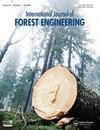Forest roads: regional perspectives from around the world
IF 2.1
3区 农林科学
Q2 FORESTRY
引用次数: 1
Abstract
ABSTRACT This paper reviews the IUFRO lecture series, Forest Roads: regional perspectives from around the world. In reviewing the presentations in this series, we found that regional factors such as geology, historic climate (glaciation), current climate, topography, and ownership strongly affect forest road networks. In addition to these regional factors, it appears that historic land use affects road design and construction. We define three road classifications: pioneer, mature, and plantation. In a pioneer road network, there is an existing forest resource and no established road network. A pioneer road network strongly reflects the current regulatory environment, current harvesting systems, and regional factors. A plantation road network occurs where there is a land use change, often from agriculture to forestry, and often growing non-native species. Plantation road networks evolve from existing rudimentary roads to road networks planned specifically for a well-defined forest resource. The plantation road network does reflect the existing regulations and harvesting systems; however, it does exist in a more constrained system that is defined by the existing roads and the boundaries of the planted forest. Mature forest road networks have evolved over centuries and incorporate historic and current land use, evolving regulations and technology, and are often interconnected with public roads. Responses specific to these road classes include a pioneer road network using brush mats to help support the subgrade, a plantation road network applying an optimized design, and a mature road network using pavement as the road surface.森林道路:来自世界各地的区域视角
摘要本文回顾了国际林研联的系列讲座“森林之路:世界各地的区域视角”。在回顾本系列的介绍时,我们发现地质、历史气候(冰川作用)、当前气候、地形和所有权等区域因素强烈影响森林公路网。除了这些区域因素外,历史土地利用似乎也会影响道路设计和建设。我们定义了三种道路分类:开拓者、成熟者和种植者。在先驱公路网中,有一个现有的森林资源,而没有建立的公路网。先锋路网强烈反映了当前的监管环境、当前的收割系统和区域因素。种植园道路网发生在土地利用发生变化的地方,通常从农业转向林业,并且通常种植非本土物种。种植园道路网络从现有的初级道路发展为专门为明确的森林资源规划的道路网络。种植园道路网确实反映了现有的法规和收割系统;然而,它确实存在于一个由现有道路和人工林边界定义的更受约束的系统中。成熟的森林公路网经过几个世纪的发展,融合了历史和当前的土地利用、不断发展的法规和技术,并经常与公共道路互联。针对这些道路类别的响应包括使用刷垫帮助支撑路基的先驱道路网络、采用优化设计的种植园道路网络以及使用路面作为路面的成熟道路网络。
本文章由计算机程序翻译,如有差异,请以英文原文为准。
求助全文
约1分钟内获得全文
求助全文

 求助内容:
求助内容: 应助结果提醒方式:
应助结果提醒方式:


